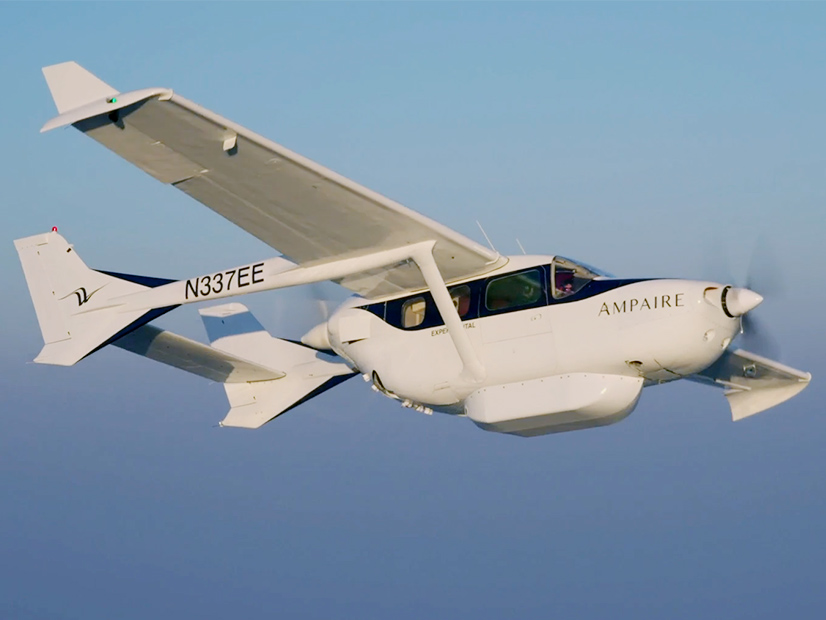U.S. commercial aviation could exceed the industry’s 50% by 2050 carbon reduction target if the companies already testing fully electric small and medium aircraft have anything to say about it.
The heads of two of these small firms changed the direction of an ARPA-E panel discussion Tuesday with presentations focusing not only on their aircraft but also on the impact smaller passenger aircraft will have on the entire industry.
The bottom line: Electric aircraft will allow the industry to return to smaller airports offering more direct flights to locations now served inefficiently, if at all, by larger aircraft.
“By going to electric smaller airplanes, lower cost, lower noise, zero emission, we can actually utilize one of the 5,000, maybe even one of the 10,000, airports that exist in the United States alone, and change the way we fly,” said Roei Ganzarski, CEO of magniX, a Washington-based electric motor manufacturer for commuter aircraft headquartered near a Boeing assembly plant.
The company’s motors have been retrofitted into several aircraft and flown successfully, said Ganzarski, a former Boeing executive. “If 50% of our [U.S. commercial] flights are less than 500 miles of range, let’s do them out of smaller airports and to small airports. That makes the door-to-door experience better and eliminates the emissions of those aircraft,” he said.
“Out of all trips in the United States 500 miles or less, only 1.6 % are done by air. That means people in the United States will drive five … to 10 hours just to avoid the hassle and the cost of our current middle-mile aviation system.”
Cory Combs, co-founder of Ampaire, said his company has been testing a modified twin-engine Cessna Skymaster in Hawaii over a 62-mile commercial route. The Cessna’s modification included an electric motor in the front and a different piston engine in the rear.
Because the electric motor runs on batteries, the modifications cut emissions. Combs described his company’s hybrid modifications as “steppingstones” to larger aircraft manufactured as hybrids for short- to medium-range flights.
“What did aviation look like before the jet engine revolution? It was looking like the DC-3 [legendary two-engine passenger plane], smaller planes that operated from a wide variety of airports,” Combs said. “Why [commercial service] shifted to the large hub airports is not actually because of passenger demand. It was because of fundamental technical limitation of jet engines. You need to go large to be efficient. A small turbine [jet engine] is not very efficient. So, you want to go large.”
“I think there’s going to be an actual segmentation switching to smaller planes operating from more airports with lower cost, lower landing fees and with lower time spent on the ground, and you’re going to see something like what’s happened with the displacement of super large aircraft,” he said.
No Magic Bullet
Sean Bradshaw, technical fellow in sustainable propulsion at Pratt & Whitney, agreed with Combs and Ganzarski.
“Electrification will be part of our future but particularly in the regional aviation space. It is relevant and will make an impact within two years. I thought the arguments were compelling, the fully electric aircraft would reduce noise and eliminate emissions,” positively impacting human health near airports, Bradshaw said. “There’s certainly a market. There is no doubt about it.”
Bradshaw also emphasized the need for technology improvements both in aircraft design and jet and turbofan engine technology. “Historically the aviation industry has improved efficiency by 1.5% per year, about evenly split between aircraft level technology improvements and engine technology improvements,” he said.
Another way to reduce the industry’s carbon footprint, he added, is to operate airports differently, including the time the aircraft spend on the tarmac.
Arjan Hegeman, general manager of the Advanced Technology Organization at GE Aviation, said he “could not agree more” with the need for electrification and the development of hybrid technologies for regional aircraft.
“Today we clearly see a big role for electrification in regional aircraft and even larger applications. The technical challenge that we’re working on overcoming as is the high amount of power to high power density,” he said, a reference to the need for high-power density batteries.
The role of hydrogen in future aviation got some discussion, including the limited supply of green hydrogen currently available.
“There is not one magic bullet; you’re going to need all solutions. You will need the alternative fuels, whether it’s [sustainable aviation fuel] or hydrogen,” Hegeman said. “It’s going to be both of them. There will be different timelines in which those are going to be introduced.”







